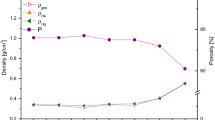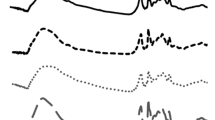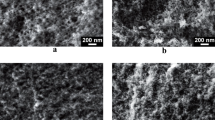Abstract
Resorcinol-formaldehyde xerogels are polymers whose porosity can be designed for a specific application by the selection of appropriate physical and chemical synthesis variables. Until recently, the methanol content of commercial formaldehyde solutions has never been considered as a chemical variable that must also be taken into account. However, it has been demonstrated that the proportion of methanol might be even more important than other variables for tailoring the porosity of xerogels. Different reaction mechanisms are proposed to explain this heavy dependence of the final structure of RF xerogels. Organic and carbon xerogels synthesized with low concentrations of methanol showed a higher porosity with much larger pore sizes (up to two orders of magnitude) than when using formaldehyde with high concentrations of methanol. This means that extra caution needs to be shown in choosing these commercial products since formaldehyde solutions differ greatly in methanol content from one supplier to another.
Graphical Abstract











Similar content being viewed by others
References
Pekala R (1989) Organic aerogels from the polycondensation of resorcinol with formaldehyde. J Mater Sci 24:3221–3227
Job N et al. (2006) Synthesis optimization of organic xerogels produced from convective air-drying of resorcinol–formaldehyde gels. J Non-Cryst Solids 352:24–34
Léonard A et al. (2008) Evolution of mechanical properties and final textural properties of resorcinol–formaldehyde xerogels during ambient air drying. J Non-Cryst Solids 354:831–838
Shen J, Hou J et al. (2005) Microstructure control of RF and carbon aerogels prepared by sol-gel process. J. Sol-Gel Sci Technol 36:131–136
Feng J, Feng J, Zhang C (2011) Shrinkage and pore structure in preparation of carbon aerogels. J Sol-Gel Sci Technol 59:371–380
Pérez-Caballero F et al. (2008) Preparation of carbon aerogels from 5-methylresorcinol–formaldehyde gels. Microporous Mesoporous Mater 108:230–236
Szczurek A et al. (2011) The use of tannin to prepare carbon gels. Part II. Carbon Cryogels Carbon 49:2785–2794
Rey-Raap N et al. (2015) Towards a feasible and scalable production of bio-xerogels. J Colloid Interface Sci 456:138–144
Moreno-Castilla C et al. (2011) Surface characteristics and electrochemical capacitances of carbon aerogels obtained from resorcinol and pyrocatechol using boric and oxalic acids as polymerization catalysts. Carbon 49:3808–3819
Zubizarreta L, Arenillas A, Pis JJ (2008) Preparation of Ni-doped carbon nanospheres with different surface chemistry and controlled pore structure. Appl Surface Sci 254:3993–4000
Szczurek A et al. (2016) Structure and properties of poly(furfuryl alcohol)-tannin polyHIPEs. Eur Polymer J 78:195–212
Rey-Raap N, Menéndez JA, Arenillas A (2014) Optimization of the process variables in the microwave-induced synthesis of carbon xerogels. J Sol-Gel Sci Technol 69:488–497
Rey-Raap N, Menéndez JA, Arenillas A (2014) RF xerogels with tailored porosity over the entire nanoscale. Microporous Mesoporous Mater 195:266–275
Rey-Raap N, Menéndez JA, Arenillas A (2014) Simultaneous adjustment of the main chemical variables to fine-tune the porosity of carbon xerogels. Carbon 78:490–499
Moreno AH et al. (2013) Carbonisation of resorcinol-formaldehyde organic xerogels: effect of temperature, particle size and heating rate on the porosity of carbon xerogels. J Anal Appl Pyrol 100:111–116
Al-Muhtaseb SA, Ritter JA (2003) Preparation and properties of resorcinol–formaldehyde organic and carbon gels. Adv Mater 15:101–114
Alonso-Buenaposada ID et al. (2015) Effect of methanol content in commercial formaldehyde solutions on the porosity of RF carbon xerogels. J Non-Cryst Solids 426:13–18
Calvo EG et al. (2011) Fast microwave-assisted synthesis of tailored mesoporous carbon xerogels. J Colloid Interface Sci 357:541–547
Singh B, Hesse R, Linford MR (2015) Good practices for XPS (and other types of) peak fitting. Vac Technol Coating 12:25–31
Figueiredo JL, Pereira (2010) MFR The role of surface chemistry in catalysis with carbons. Catal Today 150:2–7
Estrade-Szwarckopf H (2004) XPS photoemission in carbonaceous materials: a “defect” peak beside the graphitic asymmetric peak. Carbon 42:1713–1721
Mulik S, Sotiriou-Leventis C, Leventis N (2007) Time-Efficient Acid-Catalyzed Synthesis of Resorcinol– Formaldehyde Aerogels. Chem Mater 19:6138–6144
Wickenheisser M et al. (2015) Hierarchical MOF-xerogel monolith composites from embedding MIL-100(Fe,Cr) and MIL-101(Cr) in resorcinol-formaldehyde xerogels for water adsorption applications. Microporous Mesoporous Mater 215:143–153
Awadallah-F A, Elkhatat AM, Al-Muhtaseb SA (2011) Impact of synthesis conditions on meso-and macropore structures of resorcinol–formaldehyde xerogels. J Mater Sci 46:7760–7769
Alonso-Buenaposada ID et al. (2016) Desiccant capability of organic xerogels: surface chemistry vs. porous texture. Microporous Mesoporous Mater 232:70–76
Blümich B, Callaghan PT (1995) Principles of nuclear magnetic resonance microscopy. Magne Resonance Chem 33:322–322
Blumich B (2000) In NMR imaging of materials. Vol. 57 OUP Oxford
Stapf S, Han SI (2006) In NMR imaging in chemical engineering. Weinheim Wiley-VCH
Ackerman JL et al. (1987) In The use of NMR imaging to measure porosity and binder distributions in green-state and partially sintered ceramics. Massachusetts General Hospital, Boston (USA). Radiology Dept.; Argonne National Lab., IL (USA); Aluminum Co. of America, Alcoa Center, PA. Alcoa Technical Center
Garrido L (1999) Nondestructive evaluation of biodegradable porous matrices for tissue engineering. Tissue Eng Methods Protocol 18:35–45
Marcos M et al. (2006) NMR relaxometry and imaging of water absorbed in biodegradable polymer scaffolds. Magn Reson Imaging 24:89–95
Job N et al. (2005) Carbon aerogels, cryogels and xerogels: Influence of the drying method on the textural properties of porous carbon materials. Carbon 43:2481–2494
Tamon H et al. (1997) Porous structure of organic and carbon aerogels synthesized by sol-gel polycondensation of resorcinol with formaldehyde. Carbon 35:791–796
Rey-Raap N, Arenillas A, Menéndez JA (2015) Formaldehyde in the synthesis of resorcinol-formaldehyde carbon gels. In: Patton A (ed) Formaldehyde: synthesis, applications and potential health effects. Nova Science Publishers, New York, pp. 31–60
Acknowledgements
The authors gratefully acknowledge the financial support of the Ministerio de Economía y Competitividad of Spain, MINECO (Projects CTQ2014-54772-P).
Author information
Authors and Affiliations
Corresponding author
Ethics declarations
Conflict of Interest
The authors declare that they have no competing interests.
Electronic supplementary material
Rights and permissions
About this article
Cite this article
Alonso-Buenaposada, I.D., Garrido, L., Montes-Morán, M.A. et al. An underrated variable essential for tailoring the structure of xerogel: the methanol content of commercial formaldehyde solutions. J Sol-Gel Sci Technol 83, 478–488 (2017). https://doi.org/10.1007/s10971-017-4405-0
Received:
Accepted:
Published:
Issue Date:
DOI: https://doi.org/10.1007/s10971-017-4405-0




